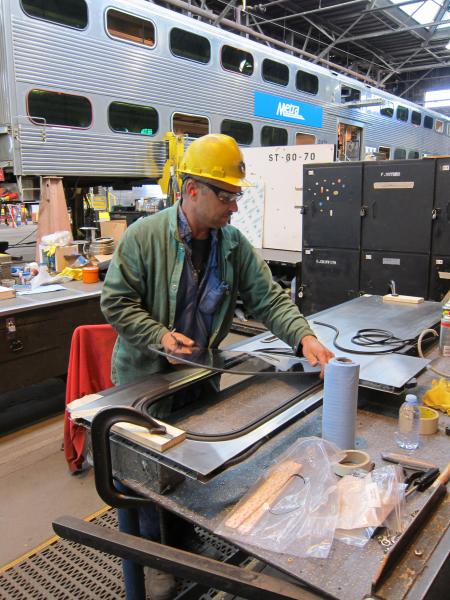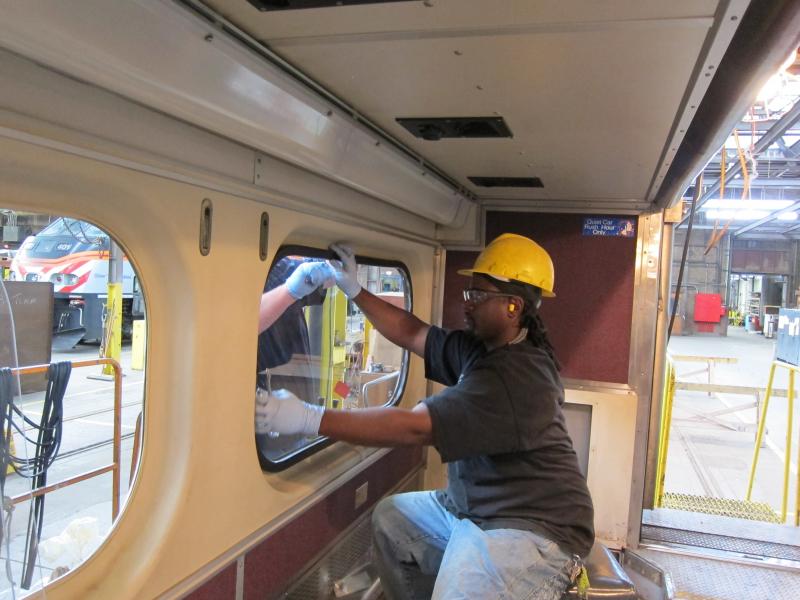We could dazzle you with all the passenger improvements we’ve added to our newly rehabbed railcars.
We could point out that the passenger cars are being refurbished in-house, by Metra workers with years of experience, dedication and know-how.
We could tell you how we’ve streamlined our processes and procedures and created an ultra-efficient operation that can strip and fully rebuild a car in just 36 days.
But we think maybe the benefit riders will most appreciate is the smallest: an electrical outlet – several of them, actually – near passenger seats that can be used to power all your gizmos.
If we sound excited by our passenger car rehabilitation program, it’s because we are. We’re getting like-new cars for a fraction of the cost of new ones, giving our riders some nice improvements and amenities and keeping 60 jobs in Chicago. It’s a win-win situation for all involved.
In 2017, the program will complete the rehabilitation of 176 cars that were built by Amerail (originally Morrison Knudson) between 1995 and 1998 and then start on another batch of 302 cars built by Nippon Sharyo in the 2000s. The work will extend the life of the cars by 12 to 15 years; with more rehabs down the road, we should be able to get 50 years of service or more out of these cars.

Carman Frank Osysko replaces a window in a door from one of the Amerail cars being rehabbed by Metra workers at the 49th St. Shop along the Rock Island Line.
What will passengers notice when they board a new car? The first thing is probably the new-car smell, actually not that different from the smell of a new automobile. When the doors close, they may notice that the doors now have sensitive edges, like elevators doors, so they will retract if they come in contact with a person or object in the way. They’ll also see new LED signs that will assist all passengers, but especially passengers with hearing disabilities, with location announcements. They will walk on new composite floors, sit on brand-new seats that meet the latest safety regulations and feel the cool air from rebuilt AC units. If they must use the bathroom, they’ll be flushing brand-new toilets, and if they’re in a wheelchair, they’ll get a ride on a new lift. And then there are the electrical outlets. There are 19 of them, spaced throughout the seating area on the lower level of the car to power all those phones, computers, iPods, iPads and other gadgets that none of us can live without any more.
All the work is done at Metra’s shop at 49th St. along the Rock Island line. The cavernous building, originally built by the Rock Island Railroad, is easily large enough to allow for four cars to be worked on at the same time, with room to spare. The efficient operation is set up as an assembly line, with four stations where various tasks are performed. Of the 60 carmen, electricians and sheet metal workers assigned to the project, about 18 work at each of the first three stations with the rest at the last station.

Carman Bryant Howse replaces a window on an Amerail passenger car at Metra’s 49th St. Shop, where the Amerail rehab program is based.
At the first station, the car is stripped: seats, bathrooms, heater guards and doors are removed. The old plymetal floor is ripped up, and the new composite floor is installed. Windows are replaced. The metal diaphragm – the accordion-like structure that connects two cars – is replaced with a rubber one. Steps are sandblasted and replaced if necessary. Electrical boxes are rebuilt and the event recorder, sort of like an airplane’s “black box,” is replaced.
At the second station, the wheelchair lift is removed and replaced with an upgraded model. The battery charger and battery box are replaced. A new retention toilet tank is installed and new heating and lighting is put in.
At the third station, all the interior work is done. That includes installing new passenger seats, rebuilt AC units, new toilets and bathroom walls, new LED signs, new windshields and new windshield wipers. Also at this station, rebuilt trucks – what the railroad industry calls the wheel assemblies – are installed.
The final station involves putting the finishing touches on the car and carrying out various tests. Painting is done and decals are installed. The batteries, battery chargers, event recorders, cab signals, LED signs, doors and other elements are tested. If the car passes the tests it is sent out into service. The cars can be found on most diesel Metra lines.
Each car spends nine days at each station and gets through all four stations in 36 days. With each car, the process gets better and better.
Click here to see a video about this program.